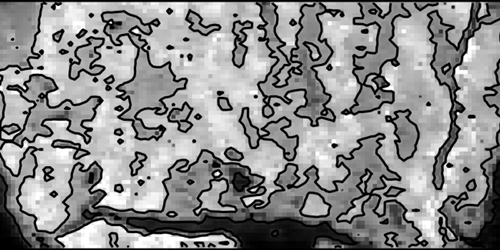Imaging Antiferromagnetic Domains
Antiferromagnetic crystals have unit cells in which a given atomic site is occupied by an atom whose magnetic moment alternates alignment from cell to cell. In a bulk antiferromagnetic material, those moments form irregular magnetic domains, 10–100 µm across, whose unit cells reverse direction from neighbor to neighbor. Now Boglárka Tóth of Budapest University of Technology and Economics in Hungary and her colleagues have demonstrated a simple way to map these domains [1]. The technique could help to harness the potentially useful spintronic properties of antiferromagnets.
The team studied lithium cobalt phosphate (LCPO), whose crystal structure features octahedral cages of oxygen ions with magnetic cobalt ions at their centers. Below 22 K, the cobalt ions orient themselves in a checkerboard pattern. Thanks to its symmetries, antiferromagnetic LCPO exhibits a magnetoelectric effect: An electric field can induce magnetization, and a magnetic field can induce electric polarization. Tóth and her collaborators realized that magnetoelectric crystals also exhibit “nonreciprocal directional dichroism” (NDD): Antiferromagnetic domains absorb light by an amount that depends on the orientation of the unit cells’ magnetic moments.
To evaluate whether NDD could be used to map antiferromagnetic domains, Tóth and her collaborators prepared thin plates of LCPO and measured the amount of light that passed through them at two orthogonal polarizations and at a range of infrared and visible wavelengths. The absorption contrast between the two polarizations turned out to be especially strong (34%) near a convenient wavelength (1550 nm) used in telecommunications. Maps produced at that wavelength clearly traced the domain boundaries. Although not all antiferromagnets exhibit NDD, Tóth says enough of them do that the new technique could prove useful as a simple way to map antiferromagnetic domains and their response to external fields.
–Charles Day
Charles Day is a Senior Editor for Physics Magazine.
References
- B. Tóth et al., “Imaging antiferromagnetic domains in LiCoPO4 via the optical magnetoelectric effect,” Phys. Rev. B 110, L100405 (2024).




